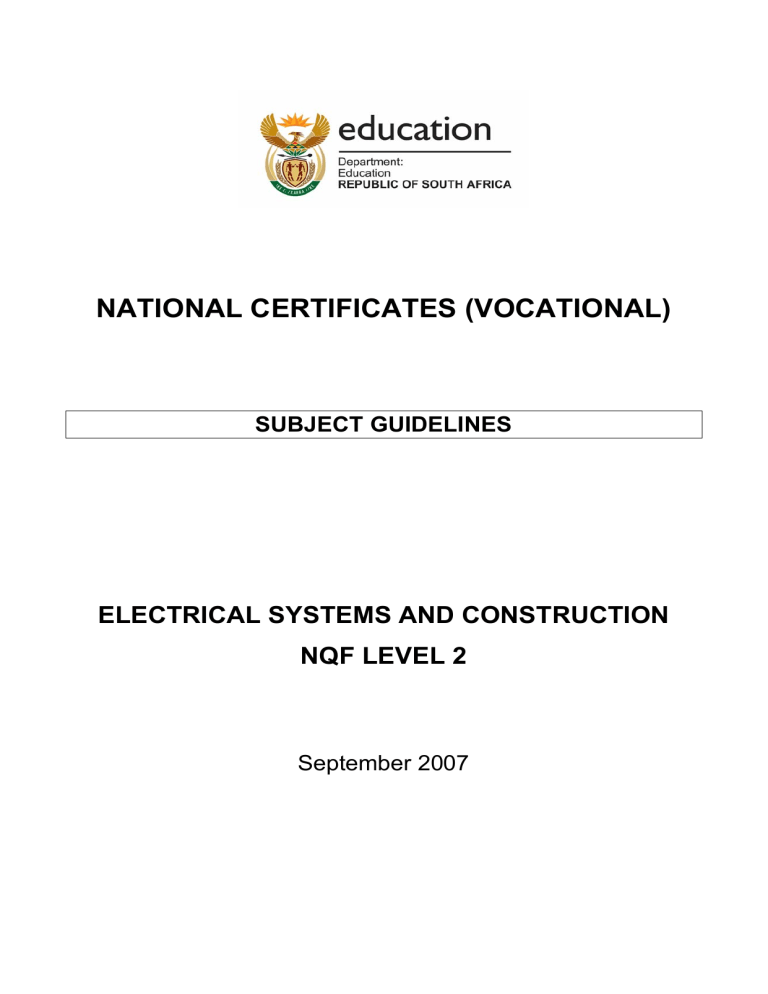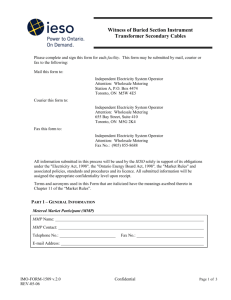
NATIONAL CERTIFICATES (VOCATIONAL) SUBJECT GUIDELINES ELECTRICAL SYSTEMS AND CONSTRUCTION NQF LEVEL 2 September 2007 Electrical Systems and Construction National Certificates (Vocational) INTRODUCTION A. What is Electrical Systems and Construction? In Level 2, Electrical Systems and Construction covers the basics of electrical systems and introduces this particular field of learning. It teaches students basic construction skills that are commonly found in the electrical field of practice. Students come into contact with standard Electrical Systems and Construction procedures. In Level 3, the subject covers the basics of electrical systems and construction procedures. In Level 4, it covers some of the daily tasks of an electrical tradesperson and introduces the practical side of this field of learning. In Levels 3 and 4, students continue with the theoretical and practical implementation of the learning material. Some of the Level 2 theoretical knowledge is repeated with greater detail to further embed students’ knowledge. B. Why is Electrical Systems and Construction important in the Electrical Infrastructure Construction programme? Electrical Systems and Construction transfers the necessary trade-specific skills, knowledge, values and attitudes so that students can understand the construction and application of electrical systems in practice. C. The link between the Electrical Systems and Construction Learning Outcomes and the Critical and Developmental Outcomes This subject covers a substantial portion of the practical knowledge component of electrical systems found in practice. With particular reference to Electrical Systems and Construction procedures, students should be able to: • Identify and solve problems: Recognise situations that require action and react appropriately. • Work effectively with others: Construct and test projects in groups or teams. • Organise and manage themselves and their activities: Apply the correct procedures for using, storing and looking after equipment, tools, test equipment, drawings and parts. • Collect, organise and evaluate information and take appropriate action: Use media centres to collect information. • Communicate effectively: Use common names for equipment, tools, test equipment, drawings and parts. • Use science and technology: Use and apply science and technology principles in both theory and practice. • Demonstrate understanding of subject content through the application of acquired knowledge: Solve problems by using subject content. D. Factors that contribute to achieving the Electrical Systems and Construction Learning Outcomes • • • • • An understanding of technical (electro-mechanical) principles Analytical ability An ability to do mathematical calculations and manipulations Practical skills Skill to interpret technical information Department of Education 1 Electrical Systems and Construction National Certificates (Vocational) ELECTRICAL SYSTEMS AND CONSTRUCTION – LEVEL 2 CONTENTS 1. DURATION AND TUITION TIME 2. SUBJECT LEVEL FOCUS 3. ASSESSMENT REQUIREMENTS 3.1. Internal assessment 3.2. External assessment 4. WEIGHTED VALUES OF TOPICS 5. CALCULATION OF FINAL MARK 6. PASS REQUIREMENTS 7. SUBJECT AND LEARNING OUTCOMES 7.1. Basic Electrical Circuits and Systems 7.2. Wire Ways and Low Voltage Cables 7.3. Electric Machines 7.4. Fault-finding and Testing 7.5. Protection and Measuring Instruments 2 Department of Education Electrical Systems and Construction National Certificates (Vocational) 1 DURATION AND TUITION TIME This is a one-year instructional programme comprising 200 teaching and learning hours. The subject may be offered on a part-time basis provided the student meets all the assessment requirements. Students with special education needs (LSEN) must be catered for in a way that eliminates barriers to learning. 2 SUBJECT LEVEL FOCUS The student should be able to: • • • • • Demonstrate understanding of the principles of electricity. Describe electrical equipment and electrical installations. Identify workshop practices and procedures. Plan the use of electrical systems. Gain practical experience in the installation of electrical systems. 3 ASSESSMENT REQUIREMENTS 3.1 Internal assessment (50 percent) All internal assessments must be finalised by an assessor with at least a certificate of competence. 3.1.1 Theoretical component The theoretical component forms 40 percent of the internal assessment mark. 3.1.2 Practical component The practical component forms 60 percent of the internal assessment mark. Practical components include applications and exercises. All practical components must be indicated in a Portfolio of Evidence (PoE). Note: Mathematical calculations that use students’ theoretical background can be considered as part of the practical component. 3.1.3 Processing of internal assessment mark for the year A year mark out of 100 is calculated by adding the marks of the theoretical component (40 percent) and the practical component (60 percent) of the internal continuous assessment (ICASS). 3.1.4 Moderation of internal assessment mark Internal assessment is subjected to internal and external moderation procedures as set out in the National Examinations Policy for FET College Programmes. 3.2 External assessment (50 percent) A National Examination is conducted annually in October or November by means of a paper(s) set and moderated externally. A practical component will also be assessed. External assessment details and procedures are set out in the Assessment Guidelines: Electrical Systems and Construction (Level 2). 4 WEIGHTED VALUES OF TOPICS TOPICS 1. 2. 3. 4. 5. WEIGHTED VALUE Basic Electrical Circuits and Systems Wire Ways and Low Voltage Cables Electric Machines Fault-finding and Testing Protection and Measuring Instruments TOTAL Department of Education 30 20 20 10 20 100 3 Electrical Systems and Construction National Certificates (Vocational) 5 CALCULATION OF FINAL MARK Internal assessment mark: Student’s mark/100 x 50 = a mark out of 50 (a) Examination mark: Student’s mark/100 x 50 = a mark out of 50 (b) Final mark: (a) + (b) = a mark out of 100 All marks are systematically processed and accurately recorded to be available as hard copy evidence for, amongst others, reporting, moderation and verification purposes. 6 PASS REQUIREMENTS The student must obtain at least fifty (50) percent in ICASS and fifty (50) percent in the examination. 7 SUBJECT AND LEARNING OUTCOMES On the completion of Electrical Systems and Electrical Construction Level 2, the student should have covered the following topics: Topic 1: Topic 2: Topic 3: Topic 4: Topic 5: 7.1 Basic Electrical Circuits and Systems Wire Ways and Low Voltage Cables Electric Machines Fault-finding and Testing Protection and Measuring Instruments Topic 1: Basic Electrical Circuits and Systems Subject Outcome 1: Test, install or replace basic electrical circuits and systems: a. A distribution board (single phase typically found in average household) b. Electrical supply entry to a dwelling (cables and conductors) c. A prepaid metering unit d. House wiring (single phase only) e. Earthing and bonding on electrical installations f. Low voltage transformers g. Electric metering units or measuring instruments (including but not limited to prepaid metering units) Learning Outcomes: The student should be able to: • Read and interpret electrical circuit diagrams and related symbols correctly. • Document the planning of the job according to accepted standards. • Adhere to working practices during the project. • Do electrical installations according to relevant SABS regulations on domestic installations. • Test the installation according to relevant SABS regulations on domestic installations. (Faults are simulated and the student does fault-finding and reports on the outcome.) • Ensure that electrical installations function and meet requirements. Work done is of an acceptable standard and worksite is left neat and tidy. • Test, install or replace a distribution board. • Test, install or replace entry to a dwelling. • Test, install, replace, commission or maintain a prepaid metering unit. • Test, install or replace earthing and bonding on electrical installations. • Test, install or replace low voltage transformers. • Test, install or replace electric metering units or measuring instruments. • Test, install or replace a luminaire unit. 7.2 Topic 2: Wire Ways And Low Voltage Cables Subject Outcome 1: Join low voltage cables. Range: a) Cables include armoured cables and cables under tension, b) terminations include lugs and terminal blocks and c).joining includes screw-its, connecting block and jointing kits 4 Department of Education Electrical Systems and Construction National Certificates (Vocational) Learning Outcomes: The student should be able to: • State types of joints commonly used to join low voltage electric cords, conductors and electric cables. • State various joining methods commonly used to join low voltage electric cords, conductors and electric cables. • Illustrate with the aid of sketches how armoured cables and cables under tension are joined. • Select the most suitable joining procedure for the application. • Join the cable, inspect and test the joint, clean the work area and store equipment correctly. • Join and solder multi-strand insulated conductors. • Use terminal blocks and screw-its for joining. • Use a joining kit to join an un-armoured cable. Subject Outcome 2: Know the purpose and design of wire ways. Learning Outcomes: The student should be able to: • State the purpose of wire ways. • Identify wire ways and know how cabling is installed. 7.3 Topic 3: Electric Machines Subject Outcome 1: Identify, inspect, clean and electrically connect and disconnect an electric machine. Range: a) DC and AC machines not exceeding 10kW and b) excludes machine installation Learning Outcomes: The student should be able to: • State statutory requirements when working on electrical machinery. • Reproduce typical connection diagrams, showing the connections to the supply or load. • Identify types of machine by supply or load connections, types of application, terminal layout, ID plate and visual appearance. • List electrical inspection procedures when working on electrical machinery. • List mechanical inspection procedures when working on electrical machinery. • Clean electrical machinery using acceptable methods. • Apply labelling before electrical disconnection and remove labelling after connection. 7.4 Topic 4: Fault-finding and Testing Subject Outcome 1: Test and find faults in electrical components. Range: Includes but is not limited to a) continuity tests, b) deviations from manufacturer's specifications and c) whether component is operational or functioning Learning Outcomes: The student should be able to: • List the possible tests that can be carried out on components. • Explain how to test and find faults in electrical components (fuses, circuit breakers, thermostats, luminaires, transformers, cabling, switches, earth leakage relays and isolators). • Test fuses, circuit breakers and switches. • Test cabling and insulation. • Test thermostats. • Test luminaires. • Test transformers. • Test earth leakage relays and isolators. • Understand if a component is faulty or functioning. 7.5 Topic 5: Protection and Measuring Instruments Subject Outcome 1: Install or replace electrical metering units or measuring instruments. Range: a. Installing and replacing under dead conditions only b. Preparation includes but is not limited to marking off, cutting, drilling and filling. Department of Education 5 Electrical Systems and Construction National Certificates (Vocational) c. Mounting includes but is not limited to direct on surface, din rail and embedded. d. Symbols and abbreviations include but are not limited to A = ammeter, V = voltmeter, KWh = kilowatt hour meter, HZ = frequency meter, PF = power factor meter, ECU = energy control unit and ED = electricity dispenser. e. Measuring instrument displays include but are not limited to analogue, digital and numeric types. f. Metering unit types include but are not limited to analogue, digital, numeric and magnetic types. Learning Outcomes: The student should be able to: • Plan to install and/or replace electrical metering units or measuring instruments. • Interpret task requirements according to instructions and/or diagrams. • Select and obtain as per specifications metering units or measuring instruments. • Select tools and equipment according to job requirements. • Identify correctly the location for mounting. • Obtain authorisation for access to restricted areas and possible downtime. • Obtain safety equipment and material required. • Communicate working schedule to affected parties. • Correctly prepare area for the mounting procedure. • Mark off metering unit or measuring instrument dimensions as per specifications. • Correctly select and use hand and power tools to meet the job requirements. • Mount and secure metering unit or measuring instrument. • Connect metering unit or measuring instrument as per instruction or specification. • Adhere to safety precautions before, during and after the mounting procedure. Subject Outcome 2: Replace a metering unit or measuring instrument. Learning Outcomes: The student should be able to: • Interpret job instructions and plan a sequence of operation. • Carry out job tasks according to the sequence of events. • Identify faulty meter and correctly select a replacement meter. • Ensure circuit is isolated according to statutory requirements and worksite procedures. • Adhere to safety precautions during the removing and replacing process. • Correctly match connections. • Replace and secure metering unit or measuring instrument according to specifications. Subject Outcome 3: Complete the installation and/or replacement of a metering unit or measuring instrument on a panel. Learning Outcomes: The student should be able to: • Ensure the re-energising of the circuit and verify the correct operation of the replaced metering unit or measuring instrument. • Discard all waste materials or scrap materials and equipment as per environmental and safety policies and standards. • Correctly check, clean and store all tools and equipment as per worksite standards and procedures. • Restore workplace to original state as per housekeeping standards and worksite procedures and standards. • Sign off and submit all relevant administration such as the job card. 6 Department of Education




